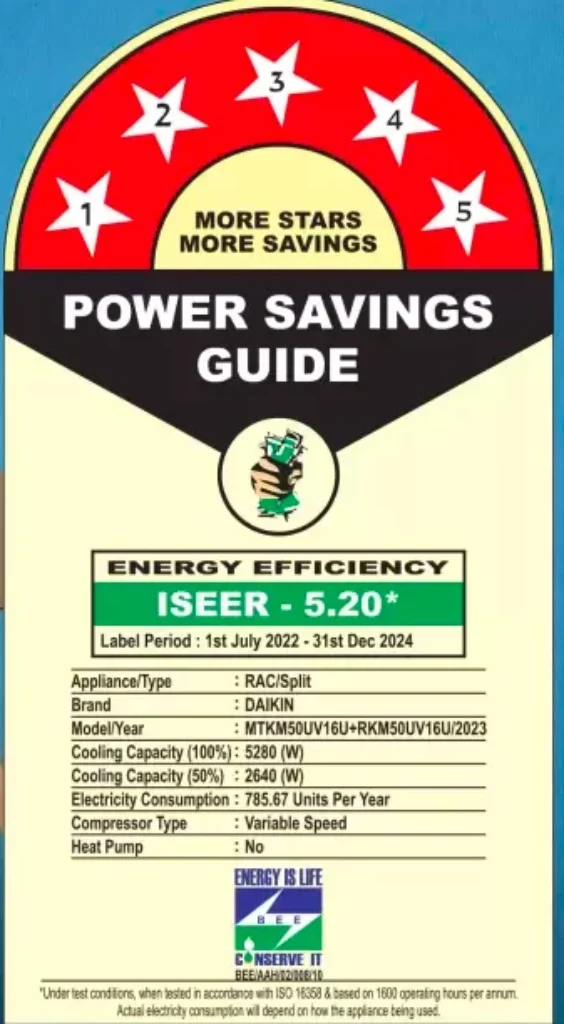
As energy efficiency and cost savings become priorities for consumers in India, it is essential to understand the power consumption of air conditioners (ACs) before making a purchase decision. In this article, we will explore the power consumption per hour of a 1 ton 5 star inverter AC in India, taking into account the Indian Seasonal Energy Efficiency Ratio (ISEER) and the impact of AC load variations on power consumption.
1 Ton 5 Star AC Power Consumption per Hour:
A 1 Ton 5 Star Inverter AC in India typically has a power consumption range of 530 watts to 580 watts. This power consumption is measured in watts per hour (Wh) or kilowatts per hour (kWh).
To calculate the power consumption per hour, we need to multiply the power rating of the AC (in kilowatts) by the number of hours it operates.
Let’s take an example:
Suppose you have a 1 Ton 5 Star Inverter AC with a power consumption of 550 watts. If you run this AC for 8 hours continuously, the power consumption per hour would be:
Power Consumption = Power Rating × Operating Hours
Power Consumption = 550 watts × 8 hours
Power Consumption = 4400 watt-hours or 4.4 kilowatt-hours (kWh) or Units.
Therefore, the power consumption of the 1 Ton 5 Star Inverter AC in this example would be 4.4 kWh per hour.
Best 1 Ton 5 Star AC in India
Understanding ISEER and Its Significance:

In India, the ISEER is used to measure the energy efficiency of ACs instead of the Energy Efficiency Ratio (EER) commonly used in other countries. The ISEER takes into account the performance of an AC under different load conditions and provides a more accurate representation of its energy efficiency. Higher ISEER ratings indicate better energy efficiency, resulting in lower power consumption.
Impact of AC Load Variation:
It is important to note that the power consumption of an AC is not always at 100% of its maximum capacity. ACs adjust their cooling output based on the cooling demand in the room. During moderate weather conditions or when the cooling load is low, the AC may operate at a lower capacity, resulting in reduced power consumption per hour.
Inverter Technology and Power Savings:
The introduction of inverter technology in ACs has revolutionized energy efficiency. Unlike conventional ACs that operate at fixed speeds, inverter ACs can adjust their compressor speed based on the cooling requirement. This ensures that the AC operates at the optimal speed, resulting in lower power consumption. Inverter ACs also have higher ISEER ratings, making them more energy-efficient compared to non-inverter models.
Maximizing Energy Efficiency of AC:
To maximize the energy efficiency of a 1 ton 5 star inverter AC and reduce power consumption, consider the following tips:
- ✅ Optimal Temperature Settings: Set the temperature to a comfortable level, preferably between 24-26 degrees Celsius, as this range is considered suitable for human comfort and promotes energy efficiency.
- ✅ Efficient Use of Timer and Sleep Mode: Utilize the timer and sleep mode features to schedule the AC’s operation according to your needs. This helps avoid unnecessary cooling and reduces power consumption.
- ✅ Regular Maintenance: Keep the AC well-maintained by cleaning or replacing air filters as recommended by the manufacturer. Regular maintenance ensures efficient airflow and optimal performance, leading to lower power consumption.
- ✅ Proper Insulation: Ensure that the room is properly insulated to prevent the loss of cooled air. Proper insulation helps the AC maintain the desired temperature with minimal power consumption.
Conclusion: A 1 ton 5 star inverter AC in India offers high energy efficiency and lower power consumption compared to non-inverter models. The ISEER rating provides a reliable measure of an AC’s energy efficiency under various load conditions. However, it is important to remember that the actual power consumption per hour can vary based on factors such as the AC load and temperature settings. By adopting energy-saving practices and utilizing the features of the AC efficiently, consumers can further optimize energy efficiency and reduce power consumption, contributing to both cost savings and environmental sustainability.








